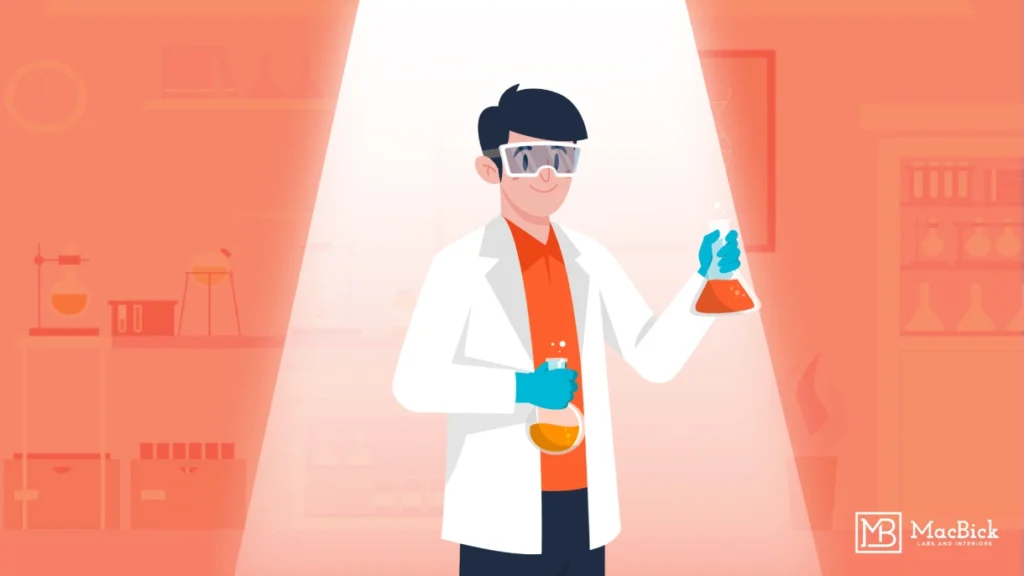Labs are busy places where accuracy, safety, and productivity matter a lot. Most people focus on tools and methods, but lighting is a crucial detail that’s often overlooked. Good lighting does more than just help you see—it impacts accuracy, safety, work efficiency, and even mood. Here’s why lighting is so important in labs.
Why Does Lighting in Labs Count?
Even in a highly advanced laboratory setting with modern design and layout, the quality and type of light are directly linked to the success and safety of the work being done. Think about it: tiny samples, intricate equipment, and the potential for hazardous materials all demand a visual environment that is second to none.
1. Accuracy in Scientific Work
Laboratory work calls for close attention to every detail. Whether people are studying tiny samples, checking small numbers on machines, or carrying out chemical reactions, good lighting is key to keeping things clear. Poor lighting can create confusion in results, which might compromise the entire experiment.
2. Improving Safety Measures
Clear visibility matters a lot in places with dangerous materials. Good lighting allows people to spot spills, notice equipment malfunctions, and follow safety protocols. This lowers the chance of accidents.
3. Increasing Productivity and Easing Fatigue
Spending long hours in dim lighting can strain the eyes and cause fatigue. Bright, well-lit areas help workers stay focused and alert. This boosts productivity and reduces errors.
4. Saving Energy and Cutting Expenses
Modern lighting options like LED lights use less energy and last much longer than traditional bulbs. They help lower electricity costs and reduce the frequency of replacements. Over time, this saves money.
How Much Light Should You Have?
Illuminance, measured in lux, indicates how much light hits a surface. Different lab tasks require different lux levels:
- General Areas: 300 to 500 lux
- Detailed Workstations: 750 to 1000 lux or more
- Microscopy: Uses built-in adjustable lighting rather than relying on overall room brightness
Consulting guidelines from industry groups such as the Illuminating Engineering Society (IES) helps determine the appropriate brightness levels for lab tasks.
Types of Lighting in Labs
Understanding how different lighting types serve different purposes can help you set up a more efficient lab:
1. Task Lighting This focused light shines on specific spots like microscope stations or work tables. It supports detailed work.
2. Ambient Lighting These lights spread throughout the room to brighten the entire lab without shadows. They make the workspace easier and more comfortable to use. Further, just like lighting, smart storage plays a vital role in boosting lab efficiency. Explore our take on innovative storage solutions for laboratories.
3. Accent Lighting Accent lighting draws attention to specific areas or equipment. It’s useful for demonstrations or highlighting key components.
How to Pick the Right Lab Lighting
Choosing the right lab lighting depends on several key factors:
- Color Rendering Index (CRI): A higher CRI ensures colors appear more accurately, which is crucial for tasks like chemical analysis.
- Illuminance Levels: Lux levels determine brightness. Tasks like microscopy require higher lux than general lab activities.
- Glare Reduction: Excessive glare strains the eyes and impairs visibility. Choose lighting designed to minimize glare.
- Durability: Lab environments can be harsh. Lighting fixtures should withstand dust, moisture, and chemical exposure.
How Natural Light Helps
Using natural light in labs offers several benefits:
- Boosts Mood and Reduces Stress: Sunlight is linked to improved mood and reduced stress.
- Supports Circadian Rhythms: It helps regulate the body’s natural rhythm, improving sleep patterns.
- Reduces Energy Use: Relying on daylight reduces the need for artificial lighting, saving energy.
Steps to Create Better Lighting in Labs
To establish effective lab lighting:
- Assess Needs: Identify tasks and choose lighting suited to each.
- Select Fixtures Wisely: Use energy-efficient fixtures that provide adequate light and minimize glare.
- Maintain Systems: Regularly inspect and maintain lighting systems to ensure optimal performance.
- Consider Environmental Conditions: Choose fixtures designed for the specific demands of lab environments.
Lighting is essential, but without design elements like color and aesthetics, a lab cannot reach its full potential. Learn how color and aesthetics also influence productivity and atmosphere in our article: The Impact of Color and Aesthetics in Lab Interiors.
Newer Technologies and Lab Lighting Trends
LED lighting is increasingly popular in labs due to its energy efficiency, longevity, and controllability. LEDs emit less heat, which benefits delicate samples and the overall lab environment. Built-in control systems allow users to dim lights or set specific lighting scenes, supporting various tasks and conserving energy when full brightness isn’t needed.
Standards such as ASTM E1733-95 offer guidance on artificial lighting in biological or environmental experiments. Light intensity and spectrum significantly influence live organisms and affect test outcomes. Labs must assess how UV light or spectral shifts may impact their work to ensure accuracy.
Step-by-Step Checklist to Plan Lab Lighting
- Identify lux levels for each task area
- Choose LED lighting with CRI 90+ and a range of 4,000–5,000K
- Install adjustable task lighting at central workbenches
- Use smart sensors and preset lighting scenes
- Conduct a two-week review post-installation with documentation and reevaluation
Wrapping It Up
Good lighting is foundational to an effective and functional lab. Understanding its role and implementing the right lighting solutions can enhance safety, precision, and workflow. Investing in high-quality lighting does more than illuminate a space—it fosters scientific progress.
FAQs
Q1: What should the CRI be for lab lighting? A CRI of 90 or higher is ideal for precise color identification, such as during chemical testing.
Q2: How do I cut down glare in a lab? Use lights with diffusers or indirect setups to reduce direct brightness and minimize glare.
Q3: Are there any energy-saving lights that work for labs? LED lights consume less power, last longer, and suit various lab activities.
Q4: What steps can I take to prevent eye fatigue while working in my lab? Ensure sufficient overall lighting, avoid reflective glare, and use task lighting for detailed work. Select lights with a good CRI and comfortable color temperature. Encourage regular breaks to rest the eyes.
Q5: What should lab lighting brightness be? General lab lighting should be around 500 lux. For detailed tasks, up to 1000 lux may be necessary. Consistent, glare-free lighting improves accuracy and comfort.
Q6: Can LED lights make labs better? Yes. LEDs provide bright, stable lighting without excess heat. They save energy and offer customizable controls for different tasks, making them ideal for labs.
Q7: Why does accurate color matter in lab lighting? Accurate color helps scientists observe specimens, chemical reactions, and test results clearly. Lighting with a CRI above 80 enhances color fidelity and reliability.


